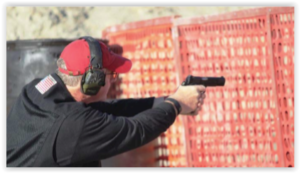A Marksman or a Sharpshooter
THE COMFORT OF PROTECTION, CAMARADERIE, AND SAFETY
 Around seven or eight years ago, I found myself going through some pretty scary areas of Texas for work. I would be driving long distances across areas in South and West Texas, where you could go for an hour or more without having any cell service. Having car problems while driving to Eagle Pass, Del Rio, or even El Paso, could spell serious trouble if you’re unprepared.
Around seven or eight years ago, I found myself going through some pretty scary areas of Texas for work. I would be driving long distances across areas in South and West Texas, where you could go for an hour or more without having any cell service. Having car problems while driving to Eagle Pass, Del Rio, or even El Paso, could spell serious trouble if you’re unprepared.
My family mentioned their concerns for me while travelling, so I knew I needed to find a way to protect myself. Although I’d never considered it before, carrying a handgun became a very real option.
Shortly after getting my first handgun, a friend from church suggested I come out shooting with him and his friends. He said it would be a great way to practice and refine my skills. I took him up on the offer because, at that point in time, I had no shooting skills to speak of. When I was growing up, my dad taught me how to use a shotgun on hunting trips, but any other type of firearm was beyond my skill level.
My Wednesday nights were soon being spent with my friend and about 30–40 other people shooting competition handgun stages. I quickly learned not just how to safely handle a gun and shoot effectively, but also how to operate under pressure and take the steps to improve my skills. Most of the people I was shooting with were also competitive shooters, so it wasn’t long before I entered my first competition pistol match.
As with any competition, there are levels of achievement. In competitive shooting, those include novice, marksman, sharpshooter, expert, and master levels. Shooters can reach a new level either by outshooting everyone else at their current level — at a major competition — or by mastering a “standard” set of stages on a shooting range.
I have less than perfect eyesight, so I’m really only ever competing against myself. That hasn’t prevented me from climbing up the competitive shooting ladder though. I currently claim the rank of sharpshooter with two different handgun models and marksman — working toward sharpshooter — with a third.
Larger pistol matches can be incredibly competitive, but they’re also a lot of fun. At the same time, there’s an enormous amount of safety and responsible gun-handling emphasized in this world. There is a time and a place for guns and the people at these competitions practice every degree of safety. You can also find a great deal of camaraderie. At pistol matches, I see kids as young as 10, and “super-senior” competitors of 70 competing against other people in their skill level. And there is no shortage of hanging out and swapping lies, tips, and stories. It’s a great experience, and I love being a part of it. For those interested in getting into competitive shooting themselves, I recommend visiting the IDPA.com website.
Beyond the enjoyment of competing and spending time with friends, I truly appreciate the reassurance that competitive shooting has giving me. Whether I’m in Texas, Oklahoma, Louisiana, or Arkansas, most of the time I’m travelling on my own. I now feel much more comfortable than I did a decade ago, because I have the ability to protect myself if needed.

